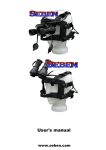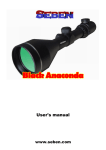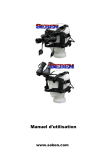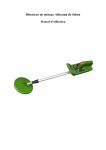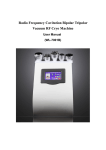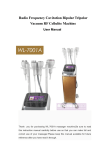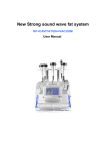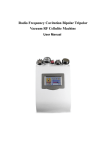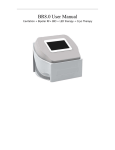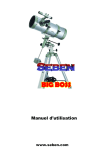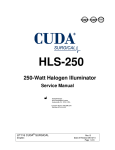Download Instruction Manual for Stereo Microscopes
Transcript
User's manual www.seben.com Instruction Manual for Stereo Microscopes Please read the booklet before using the microscope. Contents: I, Applications II, Names of the parts and accessories III, Major technical index IV, How to use V, Lamp and fuse replacement VI, Maintenance and general care of your microscope VII, Optional accessories I, Applications: Widely used in electronics industry, assembling and inspection of precise instruments and meters, educational experiments, observation and research. It can be used in the schools, research institutes, factories, and families to study the geology, outside appearance of objects. II, Names of the parts and accessories : Transmitted illuminator, frost glass stage, specimen clippers, incident lamp, objective case, fixing screw, prism housing, diopter adjustment ring, eyepiece, curve shaped pole, focusing knob, power switch, illuminator switch, light dimmer III, Major technical index: 1, Optical index(mm) Field of view Working distance (Table omitted) 2, electric index: Input voltage: 220V/50Hz Illuminating style: 1) natural light 2) incident light of 12V/10W(without transmitted illuminator) 3) incident halogen light 12V/10W(without transmitted illuminator) 4) both incident and transmitted illuminator 12V/10W 5) both incident and halogen illumina tor 12V/10W The above 5 styles are optional 3, structure index: Vertical binocular head, slanting 45 degree binocular head are optional. Diopter adjustment +/- 5 ° , inter-papillary distance adjustable 54—76mm . 4, How to use: 1) environment requirement: Dry & dust-free room, temperature between –5---+40 ? . 2) Illuminator control: Plug in the power cord into the outlet. Refer to the following table(omitted) for illumination styles. For microscopes with dimmer control the brightness of the illuminators can be adjusted. 3) select the stage: 1), The frost glass stage is placed on the base and is fixed with a screw, It is used when a transparent specimen is being observed, please use transmitted illuminator. 2) Black and white stage is kept in the packing as an accessory. When it is used, take off the glass stage and place the black and white stage on the base. Normally the white side is upward. If the specimen is white or other bright colors, then use the black side to improve the contrast with only incident illuminator. 4) Placement of specimen: Place the clean specimen in the center of the stage and fix it with clippers if necessary. 5), Use of rubber eye-guard: One pair of rubber eye guards is contained in the packing. They are used to protect against incident light around the eyepieces to improve the visibility. 6, Focusing, diopter, interpupillary adjustments: Place a specimen onto the stage. Loose the body locking thumb screw and hold the microscope head and move the body up and down to fix it at the estimated working distance. Rotate the zooming knob while looking through the right eyepiece until you see the image. Using the focusing handles to get the sharpest image of the specimen. Then look through the left eyepiece with your left eyes and turn the diopter adjustment ring until you get an image as sharp as the right side. Make this adjustment without moving the focusing handle. Then grasp the right and left prism housing and move them closer or father apart in order to match your pupil distance. Adjustment is proper when the field of view becomes comfortable and presents a full single field. 5, Warning: Disconnect the power line before you change the lamp or fuse. 1, Replacement of the incident lamp: Loosen the fixing screw and take off the lamp housing. Replace the bulb with a same new bulb. Place the lamp housing back and fix it with the same screw. 2, Replacement of the transmitted lamp: Loosen the fixing screw of the glass stage and take off the glass. Take down the broken bulb through the stage hole and install a new bulb. 3, Replacement of the fuse: The fuse case is located at the back side of the base. Unscrew the fuse case cover and put in a new one. 6, Maintenance and general care of your microscope: 1, Microscope is a delicate precision instrument and it may be damaged by dropping and hitting. 2, Do not keep microscope under sun. It should be kept in a dry and clean environment and avoid heat and strong tremor. 3, To obtain clear image, do not touch lenses with your finger. 4, All lens surface should be kept clean. If the lens get dusty blow off the dust with a rubber syringe. If necessary clean the lenses with a lint free cloth. 5, Do not use any organic material to clean the microscope surface, especially the plastic surface. It should be cleaned by neutral detergent. 6, Because the assembly of all parts has been done by skilled optical craftsmen at the factory, you should never attempt disassembly. 7, Apply a little bit grease regularly to the mechanical parts. 8, When not in use always cover the microscope with the dust cover and place it in a cool and dry place., 7,Optional parts: 1, eyepieces: 2, Dark field stage, Jewel tweezers, particularly for jewel inspections. 3, Ring lamp: The fluorescent lamp is fixed by 3 screws on the outside surface of objective case. It can be a substitute of traditional incident lamp because it is evenly lighted and the light is brighter and softer and comfortable to use.





